White spots on the skin are commonly caused by fungal infections or too much sun exposure. These conditions can be easily treated with creams and ointments as recommended by your doctor.
However, in some cases, white spots can be a sign of other skin conditions like dermatitis, hypomelanosis or vitiligo, which require a more targeted, specific treatment approach.
If you notice white spots on your skin, you should take note of their size, location and other symptoms, like itchy, dryness and flaking. A dermatologist can assess the spots, identify the underlying cause and start treatment as necessary to help reduce their appearance and manage other symptoms.
What causes white spots on the skin?
The most common causes of white spots on the skin include:
1. Peeling from sun exposure
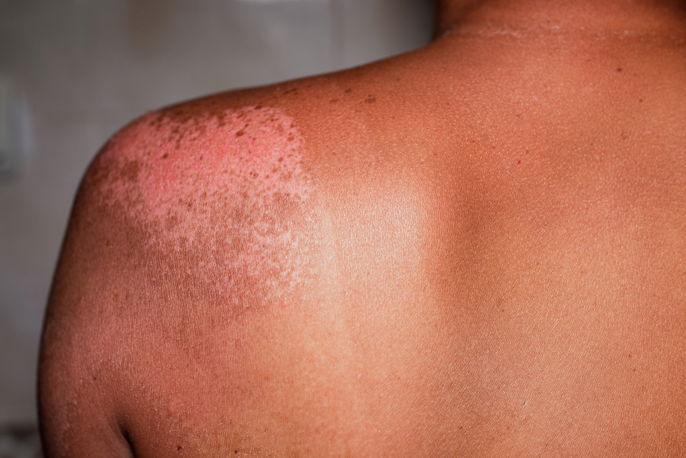
It is typical for people with lighter or olive skin to get tanned after spending a day at the beach or pool, but with excessive sun exposure, skin can peel a few days later. Skin that has peeled can cause small white patches to appear, especially on the arms, chest and back.
What to do: It is important to moisturize your skin daily, and to always apply sunscreen before going into the sun. Skin that is thinner or more sensitive has a higher risk of being sunburnt. Ideally, you should moisturize your skin thoroughly for about 10 days before a day in the sun. Foods that are high in vitamin A (like carrots, tomatoes, boiled eggs, papaya and mangos) can also help to prevent sunburns. The more hydrated the skin is, the lower the risk of peeling and developing blemishes.
2. Fungal infection
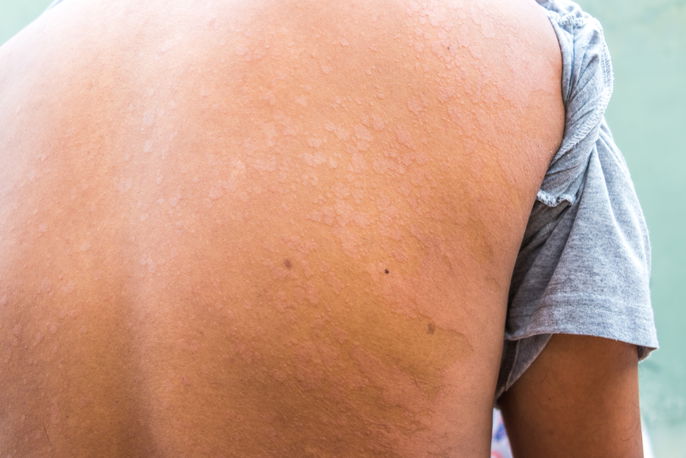
One of the most common causes of small white spots on is a fungal infection also known as pityriasis versicolor or tinea versicolor. These spots can be very itchy and can spread to other areas of the body
These white spots can become more pronounced when skin becomes tanned from the sun. The fungus that causes this infection is naturally found on the skin, but it can over-multiply and form spots on the neck, trunk or back.
What to do: Apply antifungal ointment as prescribed by a dermatologist, (e.g. isoconazole, ketoconazole or miconazole). Shampoo, soaps and gels may also be indicated to supplement the treatment. To protect other people in the house from infection, each person should use their own bath towel and avoid sharing clothes.
3. Atopic dermatitis or eczema
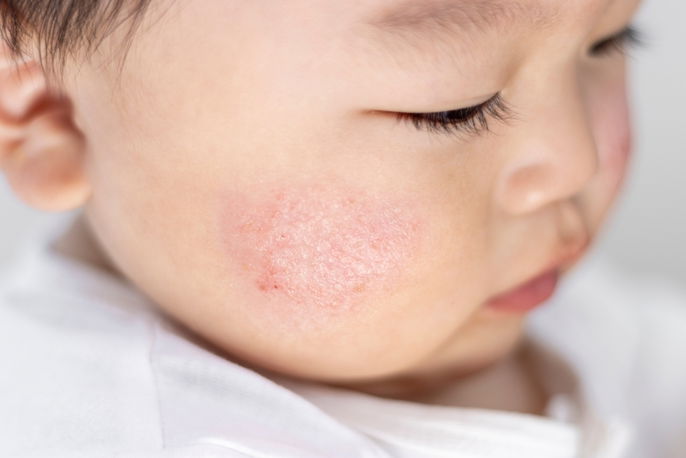
Atopic dermatitis is an inflammation of the skin that appears mostly in babies, but it can appear at any age. Dermatitis generally causes red patches, bumps or lumps with white flakes. When they disappear, they can make the skin area look whiter.
What to do: The usual treatment is steroid medication prescribed by a dermatologist twice a day. The skin should also be kept hydrated, and a antihistamine may be recommended to relieve any itching.
4. White freckles
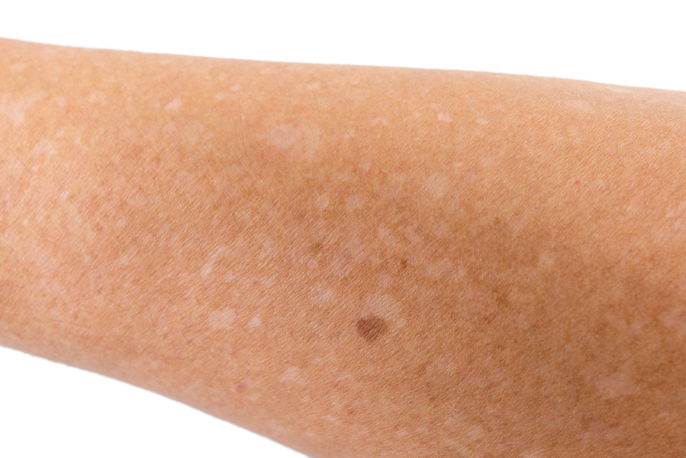
Lighter-skinned people, especially over the age of 40, can develop several small white freckles that may appear on the hands, arms or legs. This usually happens in people with fair skin or who have been exposed to the sun for many years without sunscreen.
What to do: It is recommended that you protect your skin from the sun by always using sunscreen when you go to the beach or pool, or whenever you spend more than 15 minutes out in the sun. Wearing a hat and gloves can also be helpful in preventing the sun's rays from causing skin lesions.
5. Vitiligo
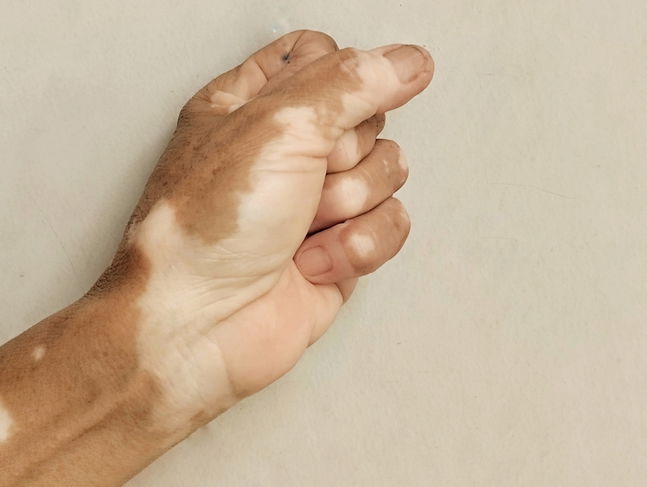
This is a disease which causes the appearance of large white patches on the skin or even inside of the mouth. Its cause isn’t fully understood, but is believed to occur due to a genetic mutation or due to an autoimmune disorder in which your body starts to attack its own melanocytes.
What to do: The doctor can indicate treatment like phototherapy, and medications like corticosteroids or immunosuppressants. One of the drugs that may be indicated is Melagenina plus, which stimulates the production of melanocytes and melanin to even out skin tone.
6. Hypomelanosis
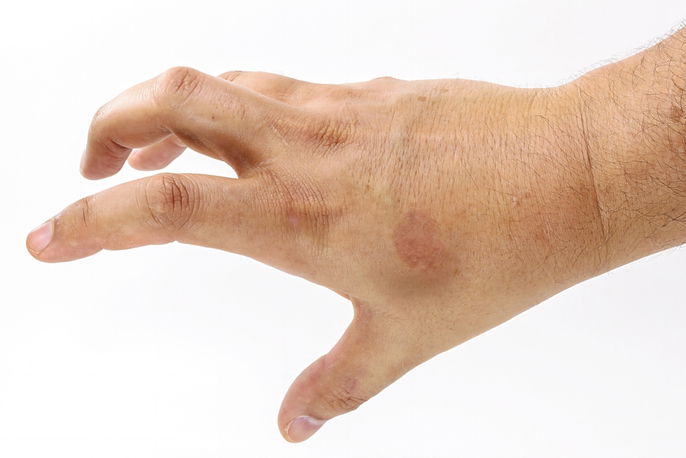
Hypomelanosis is a skin condition in which some parts of the body appear to be lighter than the person's overall skin tone. Affected skin can improve with sun exposure, but it will generally be lighter than the rest of the body. This skin change is more commonly seen in people with allergies.
What to do: Although you don’t need any specific treatment, sun exposure early in the morning or in the late afternoon may be helpful in trying to even out your skin tone.
7. Tuberous sclerosis

Also known as Bourneville disease, tuberous sclerosis is characterized by the appearance of white patches that are scattered throughout the body (although they are most commonly found around the trunk). These patches are often first seen in infants or children up to the age of 6, and can appear in various quantities (ie. just one patch or over a hundred).
What to do: You should see a dermatologist to confirm the diagnosis and start treatment to avoid any complications, such as seizures or even kidney problems.
8. Nutritional deficiencies

White spots can appear on the skin and nails due to decreased absorption of certain vitamins and minerals in the intestines. This can particularly occur with calcium, vitamin D and vitamin E deficiencies.
What to do: White spots should resolve once dietary habits are changed. You should opt for foods that are rich in nutrients like milk and dairy products, sardines, and nuts.
9. Pityriasis alba

Pityriasis alba is a skin condition that most commonly affects children and adolescents between the ages of 6 and 16. It is characterized by round or oval spots on the cheeks, arms or torso that may or may not be itchy. The spots usually appear pink, then peel and leave a white color.
The underlying cause of pityriasis alba is not fully known, however it may be related to atopic dermatitis, direct sun exposure or dry skin.
What to do: Generally speaking, pityriasis alba improves on its own within a few weeks or months. However, it is important to keep your skin hydrated by using creams or lotions after showering. You should bathe in lukewarm water, as hot water can cause dry skin, and use sun screen when going outside. The doctor may prescribe corticosteroid creams to help relieve inflammation and itching.
Can white spots be a sign of cancer?
White spots with uneven edges and different textures or colors can be a sign of non-melanoma skin cancer. If you have any concerns, consult a dermatologist for assessment and possible treatment.
Can white spots be caused by worms?
With a worm infection, it is possible to have an impairment in the absorption of vitamins and nutrients through digestion, and this can cause white spot on the skin. However, white spots do not always appear with worm infections. Some food can also cause white spots on the skin, especially those with calcium, vitamin D and vitamin E, like milk, sardines, butter and peanuts.
If the cause of white spots on the skin is actually a worm infection, this should be confirmed with a stool sample so that treatment can be initiated.






























